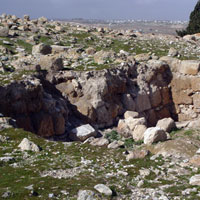 Tqoa’ is the site of several events in Old Testament, the most famous being the place of birth and burial of the prophet Amos. Living about 786 BC he raised sheep, as the Bedouin in the area still do. Though the village of Tekoa was important until at least the Crusader period. The village was subsequently relocated two kilometers west of its ancient site. The Christians of the village migrated to Bethlehem at various periods in the eighteenth century and formed the Qawawsa Quarter. Those who take the time to climb the stone-covered Khirbet Teqoa, will be rewarded by the remains of a church and monastery on top of the hill. Southeast of Tekoa is rich in ruins such as Umm Leimun, and Kasr el Abd with Byzantine remains. However it is perhaps the ruins of the New Laura, founded in 508 AD by Mar Sabas for rebel monks an hour away in Wadi Bassas which most captures the imagination. The Roman aqueduct built by Pontius Pilate bringing water from Ain Arroub past Solomon’s pools to the Haram el-Sharif area in Jerusalem was named the River of Teqoa in the middle ages because it ran through lands belonging to the village. The region extending to the Dead Sea is called the Desert of the Tekoa, while the Tekoa Valley is the greatest subterranean water reservoir in the country.
Tqoa’ is the site of several events in Old Testament, the most famous being the place of birth and burial of the prophet Amos. Living about 786 BC he raised sheep, as the Bedouin in the area still do. Though the village of Tekoa was important until at least the Crusader period. The village was subsequently relocated two kilometers west of its ancient site. The Christians of the village migrated to Bethlehem at various periods in the eighteenth century and formed the Qawawsa Quarter. Those who take the time to climb the stone-covered Khirbet Teqoa, will be rewarded by the remains of a church and monastery on top of the hill. Southeast of Tekoa is rich in ruins such as Umm Leimun, and Kasr el Abd with Byzantine remains. However it is perhaps the ruins of the New Laura, founded in 508 AD by Mar Sabas for rebel monks an hour away in Wadi Bassas which most captures the imagination. The Roman aqueduct built by Pontius Pilate bringing water from Ain Arroub past Solomon’s pools to the Haram el-Sharif area in Jerusalem was named the River of Teqoa in the middle ages because it ran through lands belonging to the village. The region extending to the Dead Sea is called the Desert of the Tekoa, while the Tekoa Valley is the greatest subterranean water reservoir in the country.
Natural Heritage Sites And Routes
Tqoa’ Area
"THE TANGIBLE AND INTANGIBLE HERITAGE THAT EXISTS FROM PREVIOUS GENERATIONS PROVIDES A LINK BETWEEN PEOPLE AND THEIR PAST"
Copyright © 2026. Centre for Cultural Heritage Preservation.



 O-Sense
O-Sense
